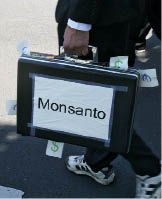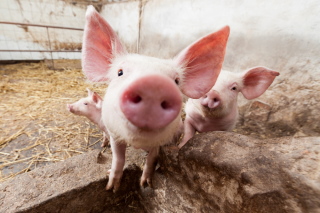Genetic Engineering: The 'Safest' Way to Get Sick
Genetic engineering is “safe”. Or so say the corporations, politicians, media, scientists and authorities in an unstoppable barrage of media fairy tales. Now powerful circles want to use the crisis to spread these dangerous lab plants all over the world. To save our livelihoods, we must all act now—firmly and with purpose.

“We want to control global food supply.” Ex-Monsanto employee Kirk Azevedo makes it clear that profit is not the only thing that matters to the leading genetic technology corporation.
Almost at the same time as Canada’s announcement, the EU Commission declared in mid July 2010 that member countries had the freedom of choice to decide whether or not to introduce genetically-modified cultivation. Upon closer inspection, it is clear that things are moving quickly: two weeks later, the EU Commission approved six genetically modified varieties of corn for import. The European Patent Office is approving more patents on ‘life’ than ever before; at the same time, thanks to years of resistance by lone warriors, the lawfulness of these patents is being debated at the highest levels. GM corporation Bayer is losing million-dollar lawsuits one after the other in the USA due to genetically engineered contamination of rice supplies, while cloned meat is illegally landing on plates in Great Britain. Switzerland is guaranteed to remain GM-free in commercial crops for another three years; in Bavaria farmers have proven their “civil courage” in the truest sense of the term and thus GM seeds as well as the all-mighty political party of the Christian Social Union have been routed. One Hessian farmer with his unbelievable story of a GM disaster is filling hall after hall with listeners—and filling his public with deep dismay.
Since 2005, areas of GM cultivation in Europe have continued to decrease, but powerful organisations want to exploit the crisis to get things off to a ‘good start’. Everything is heating up and anything is possible—the end of genetic engineering or the end of natural food. The more we know about the dangers of genetic engineering and the more resolutely we act, the greater the chance of protecting the basic resources on which life depends. We’ve already won one battle in the war: as former Nestlé boss Helmut Macher explained in 1997, one year after the first extensive, commercial cultivation of GM crops: “GM food is the food of the future. If you want to eat food in ten years time that isn’t genetically engineered, you’ll either have to starve or be very rich.” The attempt to precipitously swamp mankind with unnatural crops, presenting a fait accompli, has at least failed in Europe, Asia, Africa and Oceania.
Warning Scientists Shot Down
This failure is due to the courage of fearless people around the world who throw themselves in the path of this apparently mighty lobby without a second thought for the consequences. One of these brave people is Arpad Pusztai, a scientist commissioned by the Scottish Ministry of Agriculture in the 1990s with creating measuring methods for the safety testing of GM food. Pusztai developed a GM variety of potato that produced lectin, a substance that usually occurs in snowdrops. As the leading expert on this subject was well aware, this “snowdrop substance” was supposed to deter pests but be harmless to humans and mammals. Yet the reality was a little different: rats fed with the GM potato were more susceptible to infection and disease, the thymus gland and spleen exhibited signs of damage; some animals developed smaller brains, livers and testicles, while others displayed an enlargement of cellular tissue. Moreover, cellular changes were detected, suggesting a higher risk of stomach and bowel cancer. The rats fed with non-GM potatoes remained healthy, even though they were fed the same amount of the “snowdrop substance” as the control group—yet this time non-GM.
So how could it be that a normally totally harmless substance should suddenly cause such damage—even partially, after just ten days of feeding? At that point, the British-Hungarian scientist still didn’t know. But he did know that he needed to warn people, and quickly. His boss, Institute director Philip James, permitted the action and so on 10 August 1998 on the British current affairs programme World in Action Pusztai declared about GM food: “If I had the choice I would certainly not eat it.” And: “I find it’s very unfair to use our fellow citizens as guinea pigs.”

Corporations like Monsanto want to patent all life—for example the genetic sequence of the domestic pig.
Soon after the programme, his boss congratulated him and was evidently pleased at the breaking media interest—after all, he was hoping for good business by the sale of the tests. Yet, as Pusztai later learned from former colleagues, James then received two personal calls from former Prime Minister Tony Blair. The scientist must be silenced, was the basic message. Yet, as Pusztai was also told, there was someone even higher up on the chain: US president Bill Clinton, who was unwilling to have the “bio-technology revolution” sunk by a few Scottish scientists. Two days after his interview, Pusztai was fired. The same happened to his wife and superior Susan Bardocz, also an internationally distinguished scientist. Both were banned from talking publically and Pusztai’s work was confiscated. An unprecedented campaign took place against him; his work group, including all 19 team members, was dissolved. However, one year later, on 16 October 1999, science magazine The Lancet published the study results and backed Pusztai up, describing the effects on the stomach-bowel system in particular. The Lancet warned that these problems could also occur when consuming other genetically-modified plants.
30 Scientific Studies: 30 x Health Dangers
Yet instead of being grateful, the “scientific community” banished Pusztai from their midst forever—he had become too dangerous for his colleagues around the world. In the meantime, Pusztai had discovered why the rats had fallen sick: “The problems occurred from introducing the gene.” The foreign gene meant that the GM potato differed substantially in its protein, starch and sugar content. In other words: GM crops do not have the same value (“substantial equivalent”) as GM-free initial varieties—despite all this, the lie of “substantial equivalence” is still officially maintained today. Around the world there are about 30 independent scientific studies on the consumption of GM food, all of which, without exception, present common findings that husband and wife team Arpad Pusztai and Susan Bardocz had already discovered—namely, “worrying health effects”. Pusztai derailed the thundering genetic engineering train by his statements for the first time. The media fall-out was so immense and people’s subsequent reactions so strong that the EU Commission was forced to halt the approval of new GM organisms (GMO) between 1998 and 2004.
Yet the precedent was set, one that signalled to all scientists around the world that if you stand in the way of genetic engineering, the same could happen to you. However, some colleagues would not let themselves be cowed, but were instead guided by their conscience:
• In 1998, three scientists from the national Canadian health authorities so vehemently refused to approve the bovine growth hormone somatotropin (rBST or rBGH for short)—marketed under the brand name Posilac—that it only received national approval after their superiors put strong pressure on the scientists. In nature, somatotropin helps the cow to mobilise its physical reserves after calving to create more milk. Two injections of this GM product per month is supposed to be enough to increase the animal’s milk production by at least fifteen per cent per year—the fact that the animals cannot endure this kind of long-term stress for long is a completely different story. For one thing, the scientists based their conclusions on an alarming study; for another it was known that cows injected with this hormone suffer from udder inflammation and reproductive problems. Moreover, they also brought to light an offer to the authorities worth millions by Monsanto. Yet from this point on, the trio was “bullied, cold-shouldered, cut off,” as the scientist involved, Shiv Chopra, stated—and finally fired in 2004.
• The Russian biologist Irina Ermakova ran into problems when in 2005 she published a study on the most frequently consumed GM foods around the world. In this, she divided pregnant rats into three small groups: one was fed GM soya flour mixed into its food, one got normal soya flour and the last group’s food contained no soya flour at all. In the two groups in which the little “mothers-to-be” ate no GM soya, about 7 to 9 per cent of the young rats died within the first three weeks of life. After eating GM soya, 55.6 per cent of the young rats were dead (25 out of 45). Moreover, the “GM soya babies” weighed less at birth than the others and were also smaller on average thereafter.
• In summer 2010 another Russian, biologist Alexej V. Surov, published a different study on Monsanto GM soya, which is cultivated on 91 per cent of American soya fields. He also found disturbances in growth and reproduction: after having fed three generations of hamsters with GM soya for two years (there were several groups with differing amounts of GM soya in their diet), the results were devastating. By the third generation most of the laboratory animals were infertile. In addition, the growth of the young hamsters was greatly reduced and mortality rates among newborns rose dramatically. Unsurprisingly, these results were clearest in the group with the maximum GM soya consumption.
• French organisation CRIIGEN (Committee for Independent Research and Genetic Engineering) once again investigated the approval documents of Monsanto GM corn MON 863. In their research, laboratory animals showed signs of liver and kidney damage and had a noticeably different weight to those fed with non-GM corn varieties. “Our counter-evaluation shows that there are signs of toxicity and that nobody can say scientifically and seriously that consumption of the transgenic maize is safe and good for health,” explained research leader Gilles-Eric Séralini. The response from the EFSA (European Food Safety Authority) was as follows: the Séralini study did not provide any new “toxicologically relevant” results. This institute, in many cases called the “scandal authority”, also ignored the 2005 research results by Raffaele Mazza at the Italian University of Piacenza: pigs fed with the GM corn MON 810 grown in the EU exhibited fragments of the manipulated gene in the blood, liver, spleen and kidneys. Since then it has become obvious that the moment animals are fed with “GM food”, we will end up with GM technology on our plates through meat, eggs or milk products. According to the EFSA absolutely no tests are necessary on Pioneer‘s GM corn 59122xNK603 waved through in 2009—even though the corn contains four toxin-foreign genes. Séralini & Co. say: “Governments, biotech companies, seed companies and pesticide companies have decided to forego testing on animal food—instead they prefer to test this genetically-modified food directly on people!” When the scientist had a high-profile appearance on TV channel France 5 in early 2010 and as an expert ultimately brought down the planned aubergine cultivation in India, the French Association for Plant Bio-technology (AFBV) started a smear campaign against him and his institute.
Just how dangerous GM technology can be is shown by the normally largely side-effect-free sleeping pill L-Tryptophan in the USA: when a company changed the manufacturing process and produced the preparation with genetically-modified bacteria, mysterious illnesses increased across the country. At least 37 people died. It is thanks to informers that the connection with GM technology was clearly shown. Why conventional science still places itself in the service of the lobbies despite these kinds of practical experiences and many warning voices, is explained by Norwegian Terje Traavik, Director of Science at the independent state research centre GenØk at the University of Tromsø: “one of the greatest risk factors of genetic engineering is that 95% of all professionals in this field work directly or indirectly on the premises of the industry, while only 5% work independently, and this percentage is decreasing.”






